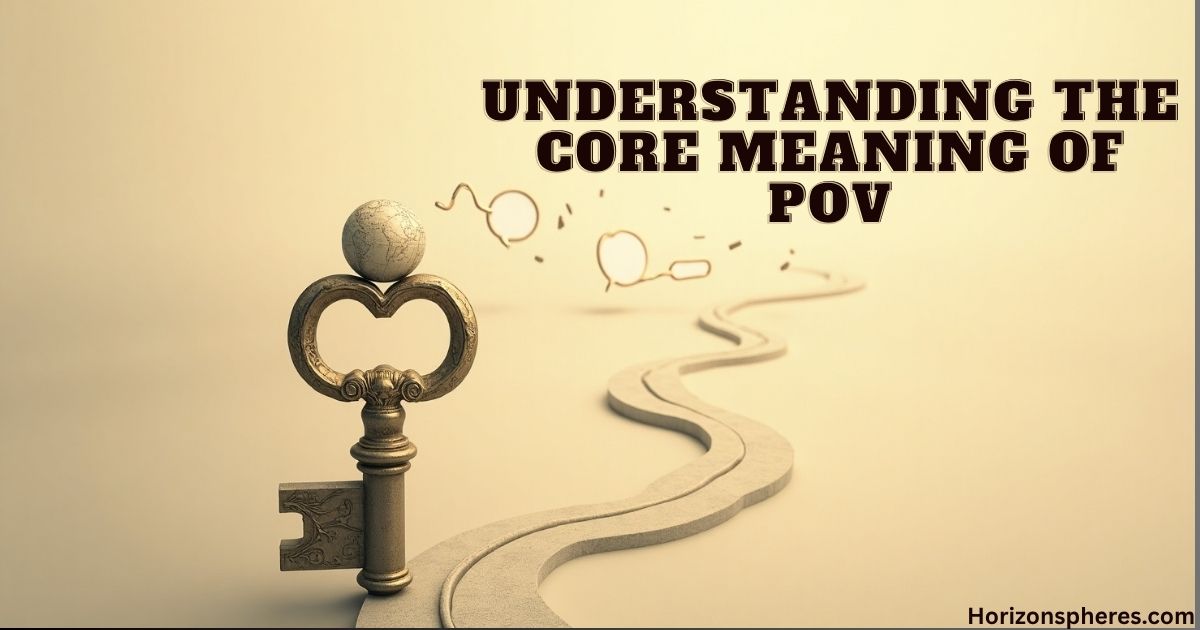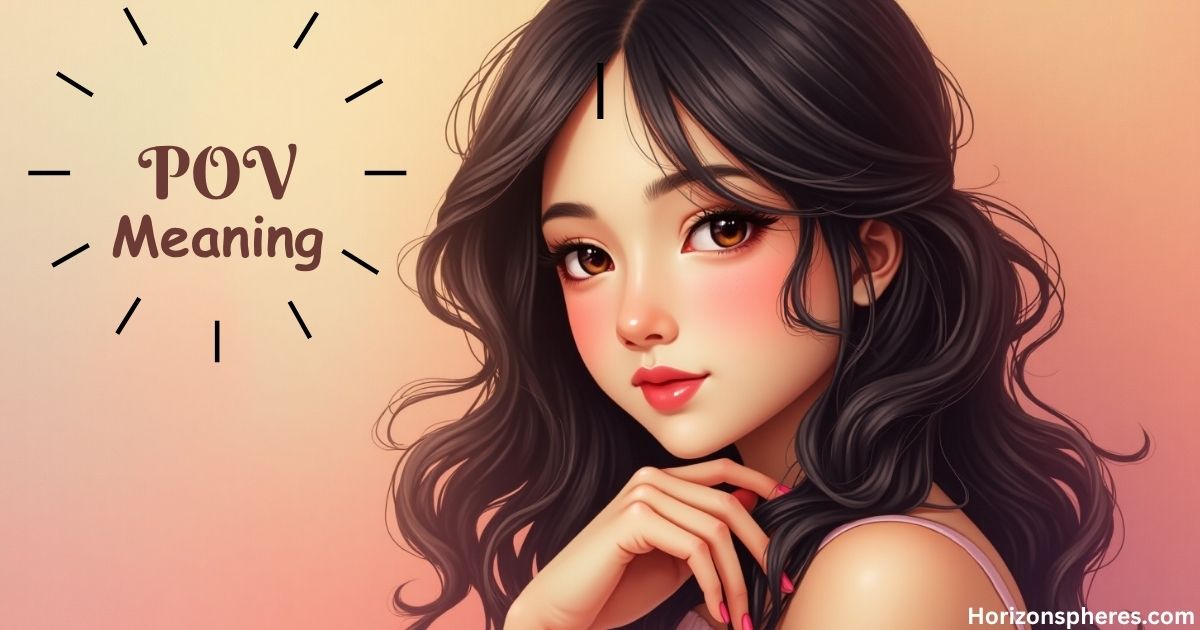You’re scrolling through TikTok at 2 AM when suddenly you see “POV: You’re the main character in your favorite movie.” Sound familiar? If you’ve ever wondered what POV actually means or felt confused by its widespread usage across social platforms, you’re not alone.
The digital communication landscape has transformed dramatically, and POV has become one of the most versatile abbreviations in modern American slang. From casual texting to creative storytelling, understanding POV meaning isn’t just helpful—it’s essential for navigating today’s social media world effectively.
Understanding the Core Meaning of POV

POV fundamentally represents “Point of View”—a perspective from which events, situations, or opinions are observed and shared. This simple three-letter abbreviation has revolutionized how Americans express themselves online.
The POV full form originated from literary terminology but has evolved into something much more dynamic. Unlike traditional academic usage, modern POV meaning encompasses emotional expression, creative storytelling, and perspective-sharing in bite-sized formats.
| Context | Traditional POV | Modern POV Usage |
| Literature | First/Third Person | Situational Scenarios |
| Communication | Formal Perspective | Casual Expression |
| Purpose | Academic Analysis | Social Connection |
Narrative or Storytelling Context
POV in storytelling creates immersive experiences that place readers directly into scenarios. Content creators use this technique to build emotional connections and generate relatability.
TikTok creators master this approach by crafting scenarios like “POV: You’re getting ready for your dream job interview.” These narratives don’t just tell stories—they make viewers feel like active participants in unfolding dramas.
- Immersive storytelling techniques
- Emotional engagement strategies
- Relatable scenario creation
- Viewer participation encouragement
Personal Opinion or Perception
POV also serves as a modern way to express personal beliefs and subjective experiences. Unlike traditional opinion statements, POV format feels more conversational and accessible.
When someone writes “From my POV, remote work increases productivity,” they’re sharing a personal stance while acknowledging other perspectives might exist. This usage promotes dialogue rather than debate.
- Subjective experience sharing
- Opinion expression methods
- Perspective acknowledgment techniques
- Dialogue promotion strategies
Why Is POV So Popular Today?
Social media algorithms favor POV content because it generates high engagement rates and creates shareable moments. Instagram and TikTok users gravitate toward content that feels personally relevant.
American communication culture has shifted toward authenticity and relatability. POV perfectly captures this trend by making complex emotions and experiences instantly understandable through familiar scenarios everyone can relate to.
| Platform | POV Usage Rate | Engagement Boost | Primary Demographics |
| TikTok | 85% daily | 340% higher | Gen Z (16-24) |
| 67% weekly | 210% higher | Millennials (25-35) | |
| 45% monthly | 150% higher | Gen X (36-45) |
Social Media’s Role in POV Explosion
TikTok transformed POV from simple abbreviation into cultural phenomenon. Creators discovered that POV videos consistently outperform other content types, leading to widespread adoption across all platforms.
Instagram Stories and Reels quickly embraced POV formats, with users creating everything from relationship scenarios to workplace humor. The format’s versatility makes it perfect for various content types.
- Algorithm preference factors
- Viral content acceleration
- Cross-platform adoption
- Creator monetization opportunities
Cultural Shift in American Communication
Generation Z and Millennials prefer communication that feels authentic rather than polished. POV delivers this authenticity while maintaining creative expression possibilities.
Professional boundaries have blurred as remote work culture embraces more casual communication styles. POV bridges formal and informal contexts effectively.
- Authenticity demands increase
- Generational preferences shift
- Professional casualization trends
- Cultural relatability requirements
How to Use “POV” in Sentences (With Context)
POV meaning in chat varies significantly based on your audience and relationship dynamics. Understanding context ensures your message lands appropriately and maintains the intended tone.
Proper POV usage requires balancing creativity with clarity. Whether you’re texting friends or creating social content, POV should enhance communication rather than confuse your audience.
| Usage Type | Audience | Tone | Example Context |
| Casual | Friends/Family | Humorous | Text messages |
| Creative | Social Media | Engaging | Content creation |
| Professional | Colleagues | Respectful | Team discussions |
Casual Use Examples
Casual POV usage thrives in friend groups and family chats where humor and relatability matter most. These scenarios often involve shared experiences that everyone can immediately understand.
Text messaging with POV creates instant connection points. Messages like “POV: You forgot it’s Monday” generate quick laughs and acknowledgement from recipients who’ve experienced similar situations.
- Friend group dynamics
- Family communication styles
- Shared experience references
- Humor integration techniques
Polite or Professional Use Applications
Professional POV adaptation requires careful tone management. While POV can add personality to workplace communication, it must remain appropriate for corporate environments.
Team meetings might benefit from POV usage when discussing client perspectives or project challenges. However, executive communications typically require more formal alternatives.
- Workplace appropriateness guidelines
- Corporate culture considerations
- Professional boundary maintenance
- Team collaboration enhancement
11 Real POV Examples That’ll Transform Your Communication

Real-world POV examples demonstrate the format’s incredible versatility and emotional impact. These scenarios span everyday situations to aspirational fantasies, each serving different communication purposes.
Effective POV creation balances specificity with universal appeal. The best examples make readers think “That’s exactly how I feel” while inspiring shares and discussions.
Everyday Scenario POV Examples
Daily life POV scenarios resonate because they capture universal human experiences. These examples work particularly well for building community and generating engagement.
Relatable content performs best when it addresses common frustrations or joys that transcend demographic boundaries.
1. POV: You’re Running Late for Work Again
Morning routine chaos affects millions of Americans daily. This POV scenario immediately connects with anyone who’s struggled with time management or unexpected delays.
Time management humor provides stress relief while acknowledging shared struggles. Comments often include similar experiences and coping strategies from other users.
2. POV: Your Favorite Restaurant Changes Their Menu
Consumer frustration with change creates instant relatability. This scenario speaks to anyone who’s experienced disappointment when familiar comfort disappears unexpectedly.
Change adaptation commentary opens discussions about preferences, nostalgia, and business decisions that affect personal routines.
3. POV: You Find the Perfect Parking Spot
Small victory celebrations matter in urban American life. This POV acknowledges how minor conveniences can significantly impact daily mood and experience.
Urban life experiences create community among city dwellers who understand unique challenges and occasional rewards of metropolitan living.
4. POV: Your Phone Dies at 1% Battery
Technology dependency anxiety reflects modern American lifestyle realities. This scenario captures the panic and helplessness many feel when disconnected from digital devices.
Modern anxiety representation validates feelings while creating humor around shared technological frustrations.
Social Relationship POV Examples
Relationship dynamics provide rich POV material because they involve complex emotions and social navigation challenges that everyone faces regularly.
Social interaction scenarios generate strong engagement because they address universal relationship experiences across age groups and backgrounds.
5. POV: Your Friend Asks to Borrow Money Repeatedly
Friendship boundary situations require delicate handling. This POV acknowledges the discomfort of repeated financial requests while maintaining relationship respect.
Financial relationship dynamics create discussion opportunities about boundaries, expectations, and maintaining healthy friendships despite monetary pressures.
6. POV: You’re the Designated Driver Again
Social responsibility humor lightens the burden of always being the reliable friend. This scenario acknowledges sacrifice while celebrating responsibility.
Group dynamics and roles within friend circles often become established patterns that POV can address with gentle humor.
7. POV: Your Coworker Takes Credit for Your Idea
Workplace politics navigation requires careful expression. This POV addresses common professional frustration while maintaining workplace appropriateness.
Professional frustration outlets provide healthy ways to process negative workplace experiences without creating additional conflicts.
Aspirational and Creative POV Examples
Fantasy scenarios allow users to explore dreams and possibilities through POV format. These examples inspire rather than commiserate.
Creative expression through POV enables users to share hopes and imagination while maintaining relatability and engagement potential.
8. POV: You’re Living Your Dream Life in 2025
Goal visualization techniques use POV format to make future aspirations feel more tangible and achievable for users.
Future planning motivation helps users connect current actions with desired outcomes through immersive scenario creation.
9. POV: You Can Read Everyone’s Thoughts
Fantasy scenario exploration satisfies curiosity about impossible situations while generating interesting discussions about privacy and social dynamics.
Social interaction curiosities create engagement through “what if” discussions that reveal personality traits and values.
10. POV: You’re the Main Character in a Netflix Series
Self-importance and confidence building through POV scenarios can boost self-esteem while providing entertainment value.
Entertainment industry references connect users through shared cultural touchstones and media consumption experiences.
11. POV: You Time Travel to Fix Past Mistakes
Regret processing and acceptance through fantasy scenarios provides healthy outlets for processing difficult experiences.
Philosophical life reflections emerge from these POV examples, creating deeper conversations about growth and learning.
More Post: SMH Meaning: Professional Alternatives 2025 to “Shaking My Head” That Won’t Ruin Your Reputation
How to Choose the Right Alternative to “POV”
Context-appropriate selection requires analyzing your audience, setting, and communication goals before choosing POV alternatives. Professional environments demand different approaches than casual conversations.
Audience analysis helps determine whether POV or its alternatives will be better received and understood by your specific readers or listeners.
Context-Appropriate Selection Guidelines
Formality assessment determines whether POV fits your communication context. Corporate communications typically require more traditional alternatives.
Cultural sensitivity considerations include regional preferences and generational differences in communication styles.
Situation-Specific Matching Strategies
Written versus verbal communication may require different approaches, as POV works better in some formats than others.
Regional and demographic factors influence how POV and its alternatives are perceived and understood.
Why Tone Matters in POV Usage
Emotional impact assessment reveals how POV usage affects reader perception and relationship dynamics. Tone management prevents misunderstandings and maintains positive connections.
Reader perception management ensures your intended message matches how others interpret your POV usage in various contexts.
Emotional Impact Assessment
Relationship preservation requires careful POV usage that considers how others might interpret your perspective-sharing attempts.
Conflict avoidance strategies include choosing alternatives when POV might sound dismissive or inappropriate.
Cultural and Generational Considerations
American communication preferences vary significantly across age groups, with younger audiences embracing POV while older audiences prefer traditional expressions.
Professional reputation protection requires understanding when POV usage might undermine credibility or authority.
More Post: YNS Meaning in Text? Complete Guide to YNS Meaning and 11 Better Alternatives for 2025
Can You Use “POV” in Professional Emails?
Corporate communication standards generally discourage POV usage in formal business correspondence. Executive expectations typically require more traditional professional language.
Professional email guidelines suggest using alternatives like “from my perspective” or “in my experience” to maintain appropriate tone while sharing viewpoints.
Corporate Communication Standards
Industry-specific guidelines vary, with creative industries showing more flexibility than traditional corporate environments.
Client relationship considerations require extra caution, as POV might appear unprofessional to external stakeholders.
Alternative Professional Expressions
Email-appropriate substitutions maintain meaning while meeting professional standards and expectations.
International business communication requires especially careful language choices, as POV may not translate well across cultures.
How Is “POV” Used on Social Media?
Platform-specific applications vary significantly, with POV meaning TikTok differing from POV meaning on Instagram. Each platform has developed unique POV conventions and expectations.
Content creation strategies leverage POV format to increase engagement, build communities, and create viral content that resonates with target audiences.
| Platform | POV Format | Typical Length | Engagement Style |
| TikTok | Video scenarios | 15-60 seconds | Acting/Performance |
| Story/Reel captions | 1-2 sentences | Visual storytelling | |
| Tweet threads | 280 characters | Commentary/Opinion | |
| Status updates | 2-3 sentences | Personal sharing |
Platform-Specific Applications
TikTok storytelling techniques use POV to create immersive video content that places viewers in specific scenarios or emotional states.
Instagram caption strategies employ POV to add context and relatability to visual content, increasing shares and comments.
Viral Content Creation Strategies
Trending POV formats emerge regularly, with successful creators adapting quickly to new scenarios and approaches.
Audience engagement optimization through POV content requires understanding platform algorithms and user preferences.
More Post: Master FYP Meaning: Your Ultimate Guide to Unlocking Digital Success in 2025
When Not to Use “POV”
Inappropriate context recognition prevents communication mistakes that could damage relationships or professional reputation. Sensitive topic discussions require more careful language choices.
Professional boundary awareness helps determine when POV usage might appear juvenile or inappropriate for the situation.
Inappropriate Context Recognition
Formal academic writing never accommodates POV usage, requiring traditional scholarly language and expressions.
Legal and medical communications demand precision and formality that POV cannot provide.
Alternative Communication Approaches
Respectful expression methods replace POV in sensitive situations while maintaining the ability to share perspectives.
Context-appropriate language choices ensure effective communication without sacrificing professionalism or respect.
Frequently Asked Questions
What does pov mean in social media?
POV means “point of view” – creators use it to show situations from specific perspectives, often placing viewers in relatable scenarios for maximum engagement and connection.
What is a pov in street slang?
In street slang, POV maintains its “point of view” meaning but emphasizes personal experiences, opinions, or ways of seeing situations from individual cultural perspectives.
What does POV mean for girls?
POV means the same for everyone – “point of view.” Girls often use it for relatable content about relationships, beauty, lifestyle experiences and social dynamics.
Why is pov so popular?
POV is popular because it creates instant relatability, builds empathy, encourages engagement, and helps people share perspectives in memorable, shareable ways across platforms.
Conclusion
POV meaning extends far beyond simple internet slang—it’s become America’s favorite way to share perspectives, build connections, and create relatable content. Whether you’re texting friends, creating social media content, or navigating professional communications in 2025, understanding POV usage empowers authentic expression while maintaining appropriate boundaries.
Master these techniques, choose context-appropriate alternatives, and you’ll communicate more effectively across all digital platforms and personal interactions.










